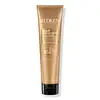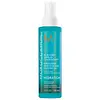What's inside
What's inside
 Key Ingredients
Key Ingredients

 Benefits
Benefits

 Concerns
Concerns

 Ingredients Side-by-side
Ingredients Side-by-side

Water
Skin ConditioningCetearyl Alcohol
EmollientBehentrimonium Methosulfate
Cetyl Esters
EmollientAmodimethicone
Argania Spinosa Kernel Oil
EmollientParfum
MaskingPhenoxyethanol
PreservativeCitric Acid
BufferingBehentrimonium Chloride
PreservativeTrideceth-6
EmulsifyingIsopropyl Alcohol
SolventCetrimonium Chloride
AntimicrobialSodium Hyaluronate
HumectantBenzyl Alcohol
PerfumingLinalool
PerfumingCoumarin
PerfumingLimonene
PerfumingHexyl Cinnamal
PerfumingCitronellol
PerfumingBenzyl Benzoate
AntimicrobialAmyl Cinnamal
PerfumingCitral
PerfumingGeraniol
PerfumingWater, Cetearyl Alcohol, Behentrimonium Methosulfate, Cetyl Esters, Amodimethicone, Argania Spinosa Kernel Oil, Parfum, Phenoxyethanol, Citric Acid, Behentrimonium Chloride, Trideceth-6, Isopropyl Alcohol, Cetrimonium Chloride, Sodium Hyaluronate, Benzyl Alcohol, Linalool, Coumarin, Limonene, Hexyl Cinnamal, Citronellol, Benzyl Benzoate, Amyl Cinnamal, Citral, Geraniol
Water
Skin ConditioningCetearyl Alcohol
EmollientPropanediol
SolventCetyl Alcohol
EmollientArgania Spinosa Kernel Oil
EmollientHelianthus Annuus Seed Oil
EmollientHordeum Vulgare Seed Extract
Skin ConditioningParfum
MaskingHydrolyzed Rice Protein
Skin ConditioningHydrolyzed Quinoa
Skin ConditioningWheat Amino Acids
Skin ConditioningSoy Amino Acids
Skin ConditioningCitric Acid
BufferingGlucose
HumectantGlycerin
HumectantDimethicone
EmollientCaprylic/Capric Triglyceride
MaskingBehentrimonium Methosulfate
Stearamine Oxide
CleansingOlealkonium Chloride
Behentrimonium Chloride
PreservativeAmodimethicone
Isopropyl Alcohol
SolventCaprylic/Capric Glycerides Polyglyceryl-10 Esters
EmollientXylitylglucoside
HumectantGuar Hydroxypropyltrimonium Chloride
Skin ConditioningAnhydroxylitol
HumectantGlyceryl Stearate Se
EmulsifyingCinnamidopropyltrimonium Chloride
Xylitol
HumectantTrideceth-12
EmulsifyingPolyquaternium-7
Polyquaternium-11
C12-13 Pareth-9
EmulsifyingCetrimonium Chloride
AntimicrobialArginine Hcl
Skin ConditioningSerine
MaskingThreonine
Algin
MaskingChitosan
Potassium Sorbate
PreservativeSodium Benzoate
MaskingBenzyl Alcohol
PerfumingPhenoxyethanol
PreservativeWater, Cetearyl Alcohol, Propanediol, Cetyl Alcohol, Argania Spinosa Kernel Oil, Helianthus Annuus Seed Oil, Hordeum Vulgare Seed Extract, Parfum, Hydrolyzed Rice Protein, Hydrolyzed Quinoa, Wheat Amino Acids, Soy Amino Acids, Citric Acid, Glucose, Glycerin, Dimethicone, Caprylic/Capric Triglyceride, Behentrimonium Methosulfate, Stearamine Oxide, Olealkonium Chloride, Behentrimonium Chloride, Amodimethicone, Isopropyl Alcohol, Caprylic/Capric Glycerides Polyglyceryl-10 Esters, Xylitylglucoside, Guar Hydroxypropyltrimonium Chloride, Anhydroxylitol, Glyceryl Stearate Se, Cinnamidopropyltrimonium Chloride, Xylitol, Trideceth-12, Polyquaternium-7, Polyquaternium-11, C12-13 Pareth-9, Cetrimonium Chloride, Arginine Hcl, Serine, Threonine, Algin, Chitosan, Potassium Sorbate, Sodium Benzoate, Benzyl Alcohol, Phenoxyethanol
 Reviews
Reviews

Ingredients Explained
These ingredients are found in both products.
Ingredients higher up in an ingredient list are typically present in a larger amount.
This water-soluble silicone is used for its hydrating and softening properties. It is used to add a silky feel to skincare products and has great benefits for haircare.
In haircare, this ingredient:
- Adds shine
- Protects color
- Offers thermal protection
- Boosts hair strength
- Does not build up as easily
You may know this ingredient as argan oil. Argan Oil has antioxidant, hydrating, and soothing properties.
Studies have shown argan oil can help fight again radical damage from the sun. This makes it effective at preventing hyperpigmentation.
Large amounts of vitamin E found in argan oil helps the skin retain water. Argan oil also contains fatty acids such as linoleic acid, oleic acid, and palmitic acid. It is also a good source of lipids.
Another benefit of argan oil is skin-soothing. It can help reduce inflammation-related skin symptoms.
Argan Oil is effective at regulating sebum production in pores. This can make it effective at treating hormonal acne.
Traditionally, argan oil was used for its antibacterial and antifungal properties. However, argan oil contains fatty acids that may make it not fungal-acne safe.
Argan Trees are native to Morocco.
Learn more about Argania Spinosa Kernel OilThis ingredient is a preservative and often used for it's anti-static properties. You'll most likely see this ingredient in hair conditioners.
It does not cause irritation or sensitization in leave-on products at 1-5%.
Behentrimonium Methosulfate is an ammonium salt. It is mainly used to prevent static in haircare products as a surfactant.
Surfactants have differing ends: one side is hydrophilic while the other end is hydrophobic.
Surfactants also help your cleansers remove pollutants more easily from the skin.
Learn more about Behentrimonium MethosulfateBenzyl Alcohol is most commonly used as a preservative. It also has a subtle, sweet smell. Small amounts of Benzyl Alcohol is not irritating and safe to use in skincare products. Most Benzyl Alcohol is derived from fruits such as apricots.
Benzyl Alcohol has both antibacterial and antioxidant properties. These properties help lengthen the shelf life of products. Benzyl Alcohol is a solvent and helps dissolve other ingredients. It can also improve the texture and spreadability.
Alcohol comes in many different forms. Different types of alcohol will have different effects on skin. This ingredient is an astringent alcohol.
Using high concentrations of these alcohols are drying on the skin. They may strip away your skin's natural oils and even damage your skin barrier. Astringent alcohols may also irritate skin.
Other types of astringent alcohols include:
According to the National Rosacea Society based in the US, you should be mindful of products with these alcohols in the top half of ingredients.
Any type of sanitizing product will have high amounts of alcohol to help kill bacteria and viruses.
Learn more about Benzyl AlcoholCetearyl alcohol is a mixture of two fatty alcohols: cetyl alcohol and stearyl alcohol. It is mainly used as an emulsifier. Emulsifiers help prevent the separation of oils and products. Due to its composition, it can also be used to thicken a product or help create foam.
Cetearyl alcohol is an emollient. Emollients help soothe and hydrate the skin by trapping moisture.
Studies show Cetearyl alcohol is non-toxic and non-irritating. The FDA allows products labeled "alcohol-free" to have fatty alcohols.
This ingredient is usually derived from plant oils such as palm, vegetable, or coconut oils. There is debate on whether this ingredient will cause acne.
Due to the fatty acid base, this ingredient may not be Malassezia folliculitis safe.
Learn more about Cetearyl AlcoholThis ingredient is a preservative, antimicrobial, and emulsifier. It is often used in cosmetics for its ability to cleanse, condition, and reduce static.
Cetrimonium chloride is a quaternary ammonium salt, meaning it has a water-soluble structure.
Citric Acid is an alpha hydroxy acid (AHA) naturally found in citrus fruits like oranges, lemons, and limes.
Like other AHAs, citric acid can exfoliate skin by breaking down the bonds that hold dead skin cells together. This helps reveal smoother and brighter skin underneath.
However, this exfoliating effect only happens at high concentrations (20%) which can be hard to find in cosmetic products.
Due to this, citric acid is usually included in small amounts as a pH adjuster. This helps keep products slightly more acidic and compatible with skin's natural pH.
In skincare formulas, citric acid can:
While it can provide some skin benefits, research shows lactic acid and glycolic acid are generally more effective and less irritating exfoliants.
Most citric acid used in skincare today is made by fermenting sugars (usually from molasses). This synthetic version is identical to the natural citrus form but easier to stabilize and use in formulations.
Read more about some other popular AHA's here:
Learn more about Citric AcidIsopropyl Alcohol is more commonly known as rubbing alcohol. It is most commonly used as a solvent, meaning it helps other ingredients dissolve.
This ingredient is an astringent alcohol. Astringent alcohols may also irritate skin as they high amounts may strip away your skin's natural oils.
Other types of astringent alcohols include:
According to the National Rosacea Society based in the US, you should be mindful of products with these alcohols in the top half of ingredients.
Any type of sanitizing product will have high amounts of alcohol to help kill bacteria and viruses.
Learn more about Isopropyl AlcoholParfum is a catch-all term for an ingredient or more that is used to give a scent to products.
Also called "fragrance", this ingredient can be a blend of hundreds of chemicals or plant oils. This means every product with "fragrance" or "parfum" in the ingredients list is a different mixture.
For instance, Habanolide is a proprietary trade name for a specific aroma chemical. When used as a fragrance ingredient in cosmetics, most aroma chemicals fall under the broad labeling category of “FRAGRANCE” or “PARFUM” according to EU and US regulations.
The term 'parfum' or 'fragrance' is not regulated in many countries. In many cases, it is up to the brand to define this term.
For instance, many brands choose to label themselves as "fragrance-free" because they are not using synthetic fragrances. However, their products may still contain ingredients such as essential oils that are considered a fragrance by INCI standards.
One example is Calendula flower extract. Calendula is an essential oil that still imparts a scent or 'fragrance'.
Depending on the blend, the ingredients in the mixture can cause allergies and sensitivities on the skin. Some ingredients that are known EU allergens include linalool and citronellol.
Parfum can also be used to mask or cover an unpleasant scent.
The bottom line is: not all fragrances/parfum/ingredients are created equally. If you are worried about fragrances, we recommend taking a closer look at an ingredient. And of course, we always recommend speaking with a professional.
Learn more about ParfumPhenoxyethanol is a preservative that has germicide, antimicrobial, and aromatic properties. Studies show that phenoxyethanol can prevent microbial growth. By itself, it has a scent that is similar to that of a rose.
It's often used in formulations along with Caprylyl Glycol to preserve the shelf life of products.
Water. It's the most common cosmetic ingredient of all. You'll usually see it at the top of ingredient lists, meaning that it makes up the largest part of the product.
So why is it so popular? Water most often acts as a solvent - this means that it helps dissolve other ingredients into the formulation.
You'll also recognize water as that liquid we all need to stay alive. If you see this, drink a glass of water. Stay hydrated!
Learn more about Water